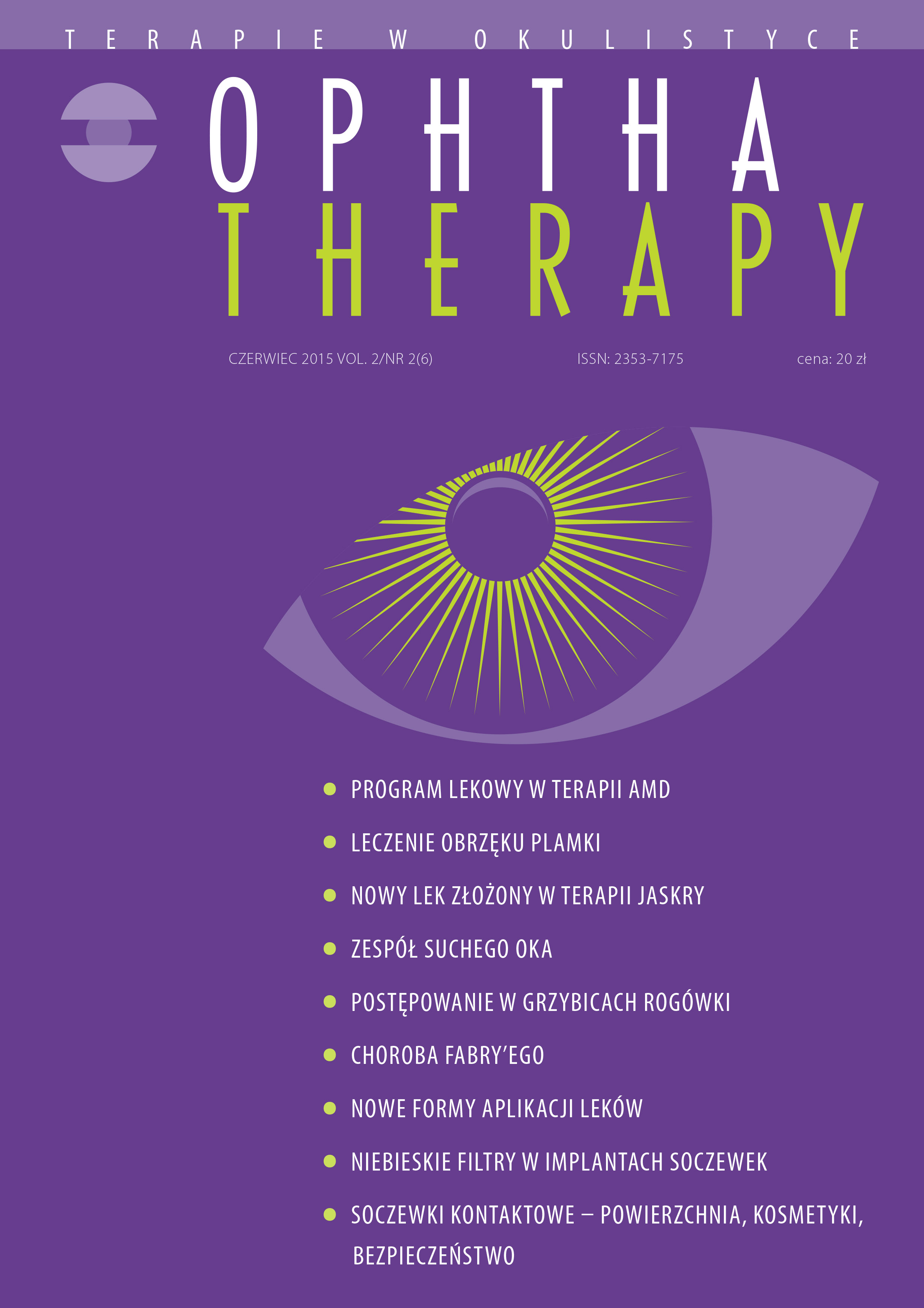Powierzchnia soczewek kontaktowych a bezpieczeństwo i komfort użytkowania
##plugins.themes.bootstrap3.article.main##
Abstrakt
Soczewki kontaktowe są coraz popularniejszą metodą korekcji i coraz więcej specjalistów sięga po takie rozwiązanie dla swoich pacjentów. Mimo postępu technologicznego cały czas mamy jednak do czynienia z porzuceniami soczewek kontaktowych. Przyczyna, która jest wskazywana jako najważniejsza, to dyskomfort. Badania jednoznacznie pokazują, że komfort użytkowania soczewek jest związany z ich powierzchnią – powierzchnie zmodyfikowane, o dużym współczynniku lubrykacji dają dużo lepsze efekty. Co więcej, sama powierzchnia soczewek jest odpowiedzialna za gromadzenie się osadów, a to ma już bezpośredni wpływ na bezpieczeństwo.
Pobrania
##plugins.themes.bootstrap3.article.details##

Utwór dostępny jest na licencji Creative Commons Uznanie autorstwa – Użycie niekomercyjne – Bez utworów zależnych 4.0 Międzynarodowe.
Copyright: © Medical Education sp. z o.o. License allowing third parties to copy and redistribute the material in any medium or format and to remix, transform, and build upon the material, provided the original work is properly cited and states its license.
Address reprint requests to: Medical Education, Marcin Kuźma (marcin.kuzma@mededu.pl)
Bibliografia
2. Young G, Veys J, Pritchard N et al. A multi-centre study of lapsed contact lens wearers. Ophthalmic Physiol Opt. 2002; 22(6): 516-27.
3. Bontempo AR, Rapp J. Protein and lipid deposition onto hydrophilic contact lenses in vivo. CLAO J. 2001; 27(2): 75-80.
4. Rumpakis J. New data on contact lens dropouts: An international perspective. Review of Optometry. 2010. Online: http:// www.revoptom.com/content/d/contact_lenses_and_solutions/c/18929 (Access: 15.01.2010).
5. Dumbleton K, Woods CA, Jones LW et al. The impact of contemporary contact lenses on contact lens discontinuation. Eye Contact Lens. 2013; 39(1): 93-9.
6. Fonn D, Situ P, Simpson TL. Hydrogel lens dehydration and subjective comfort and dryness ratings in symptomatic and asymptomatic contact lens wearers. Optom Vis Sci. 1999; 76(10): 700-4.
7. Nichols JJ, Jones L, Nelson JD et al. The TFOS International Workshop on Contact Lens Discomfort: Introduction. Invest Ophthalmol Vis Sci. 2013 October; 54: TFOS1-TFOS6. https://doi.org/10.1167/iovs.13-13195.
8. Nichols JJ, Willcox MDP, Bron AJ et al. The TFOS International Workshop on Contact Lens Discomfort: Executive Summary. Invest Ophthalmol Vis Sci. 2013 October; 54: TFOS7-TFOS13. https://doi.org/10.1167/iovs.13-13212.
9. Morgan PB, Woods CA, Tranoudis IG et al. International contact lens prescribing in 2011. Contact Lens Spectrum. 2012; 27(1): 26-31.
10. Pritchard N, Fonn D. Dehydration, lens movement and dryness ratings of hydrogel contact lenses. Ophthalmic Physiol Opt. 1995; 15(4): 281-6.
11. Zhao Z, Carnt NA, Aliwarga Y et al. Care regimen and lens material influence on silicone hydrogel contact lens deposition. Optom Vis Sci. 2009; 86(3): 251-9.
12. Tighe B. Silicone hydrogels: Structure, properties and behaviour. In: Sweeney D (ed). Silicone Hydrogels: Continuous Wear Contact Lenses. Butterworth-Heinemann, Oxford 2004: 1-27.
13. Panaser A, Tighe BJ. Function of lipids – their fate in contact lens wear: an interpretive review. Cont Lens Anterior Eye. 2012; 35(3): 100-11.
14. Dogru M, Ward SK, Wakamatsu T et al. The effects of 2 week senofilcon-A silicone hydrogel contact lens daily wear on tear functions and ocular surface health status. Cont Lens Anterior Eye. 2011; 34(2): 77-82.
15. Nash W, Gabriel M, Mowrey-Mckee M. A comparison of various silicone hydrogel lenses; lipid and protein deposition as a result of daily wear. Optom Vis Sci. 2010; 87: E-abstract: 105110.
16. Pruitt J, Qiu Y, Thekveli S et al. Surface characterization of a water gradient silicone hydrogel contact lens (delefilcon A). Invest Ophthal Vis Sci. 2012; 53: E-abstract 6107.
17. Sawyer WG. Lubricity in high water content surface gel layers. Optom Vis Sci. 2012; 89: E-abstract 125089.
18. Berry M, Pult H, Purslow C et al. Mucins and ocular signs in symptomatic and asymptomatic contact lens wear. Optom Vis Sci. 2008; 85(10): E930-8.
19. Pult H, Purslow C, Berry M et al. Clinical tests for successful contact lens wear: relationship and predictive potential. Optom Vis Sci. 2008; 85(10): E924-9.
20. Donshik PC. Contact lens chemistry and giant papillary conjunctivitis. Eye Contact Lens. 2003; 29(1 supl.): S37-9.
21. Korb DR, Greiner JV, Herman JP et al. Lid-wiper epitheliopathy and dry-eye symptoms in contact lens wearers. CLAO J. 2002; 28(4): 211-6.

